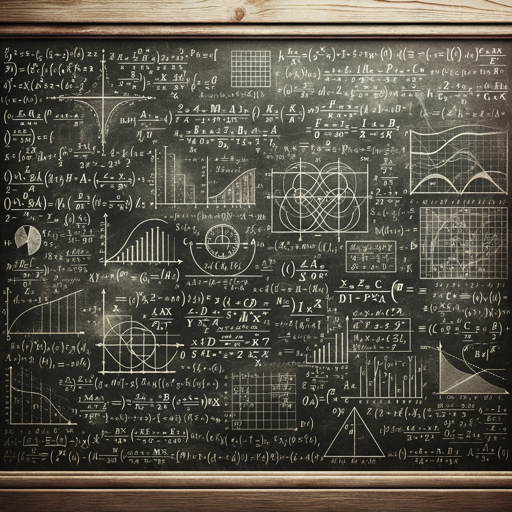Trigonometry-Trigonometry guide and solutions
AI-powered trigonometry tool for everyone
Explain sine and cosine.
How is trigonometry used in real life?
Solve this trigonometry problem.
What are the basics of trigonometry?
Related Tools
Load More
Geometry Calculator
Most versatile solver for geometry and trigonometry. Easy to understand with step-by-step explanations. Powered by Solvely.

Math and Statistics Pro
Expert in solving high-level math and statistics problems.

Advanced Math and Matrix Expert
Deep expertise in matrix diagonalization and applications.

Advanced Math and Finance Solver
Expert in solving math and financial engineering problems.

Trig Professor
A trigonometry professor, ready to prepare users for calculus with expert guidance.

Pre Calc Pro
Expert in AP Pre-Calculus, provides simple, step-by-step math solutions.
20.0 / 5 (200 votes)
Introduction to Trigonometry
Trigonometry is a branch of mathematics that studies relationships between the sides and angles of triangles. It is fundamental in understanding and describing the properties of waves, circles, and oscillations. Trigonometry is essential in various fields such as physics, engineering, astronomy, and even in art and architecture. The core functions of trigonometry are the sine, cosine, and tangent, which are derived from right-angled triangles and are used to solve for unknown sides or angles. For example, if you know the length of one side of a right triangle and an angle, you can use these functions to find the other side lengths.

Main Functions of Trigonometry
Sine (sin)
Example
In a right-angled triangle, the sine of an angle is the ratio of the length of the opposite side to the length of the hypotenuse.
Scenario
In physics, the sine function can be used to model waveforms, such as sound waves. For instance, the displacement of a vibrating string at any point in time can be represented using the sine function.
Cosine (cos)
Example
In a right-angled triangle, the cosine of an angle is the ratio of the length of the adjacent side to the length of the hypotenuse.
Scenario
In engineering, the cosine function is often used in signal processing. For example, it helps in analyzing alternating current (AC) circuits where the voltage and current can be modeled as cosine functions of time.
Tangent (tan)
Example
In a right-angled triangle, the tangent of an angle is the ratio of the length of the opposite side to the length of the adjacent side.
Scenario
In architecture, the tangent function can be used to determine the slope of a roof. By knowing the height of the roof and the length of the building, architects can calculate the angle of elevation using the tangent function.
Ideal Users of Trigonometry
Students
Students studying mathematics, physics, engineering, and related fields benefit from trigonometry by gaining a foundational understanding of geometric relationships. This knowledge is crucial for solving problems in various scientific and technical disciplines.
Professionals
Engineers, architects, physicists, and surveyors regularly use trigonometry in their work. For instance, engineers use trigonometry to design mechanical structures and analyze forces, while surveyors apply it to measure land and distances accurately.

How to Use Trigonometry
Step 1
Visit aichatonline.org for a free trial without login, no need for ChatGPT Plus.
Step 2
Understand the basic trigonometric functions: sine, cosine, and tangent, which relate the angles of a triangle to the lengths of its sides.
Step 3
Learn how to use the unit circle, which helps in understanding how these trigonometric functions behave for different angles.
Step 4
Practice solving right-angle triangle problems using trigonometric ratios. For example, find missing angles or side lengths.
Step 5
Apply trigonometry in real-world scenarios such as navigation, architecture, and physics problems to solidify your understanding.
Try other advanced and practical GPTs
HondaGOLFのGPT
AI-driven responses for Honda’s golf community.

인터넷신문기사발행기
AI-driven content creation made simple.

Atlys SEO GPT
AI-Powered SEO and Content Strategy.

キジコウ見直しAI
Enhance your articles with AI power.

Spa
AI-powered relaxation and wellness tool.

German Translator
AI-driven translations for business success

TubeCaption
AI-powered YouTube Subtitle Extractor

HondaDog_GPT
AI-driven pet engagement and social media content

ReWrite-GPT
AI-driven content rewriting made simple

LinkedGPT
Maximize LinkedIn engagement with AI-driven posts.

JustDoIt Bot
AI-powered insights for smarter marketing.

Ad Strategy Analyst
AI-driven insights for brand ad strategies

- Education
- Architecture
- Engineering
- Navigation
- Physics
Trigonometry Q&A
What are the primary trigonometric functions?
The primary trigonometric functions are sine (sin), cosine (cos), and tangent (tan). These functions relate the angles of a triangle to the lengths of its sides.
How is the unit circle used in trigonometry?
The unit circle is a circle with a radius of one centered at the origin of a coordinate plane. It helps in understanding the values of trigonometric functions for different angles, providing a visual representation of sine and cosine.
What are some common applications of trigonometry?
Common applications of trigonometry include solving problems in navigation, engineering, physics, architecture, and even computer graphics. It is used to calculate distances, angles, and to model periodic phenomena.
How can I solve a right triangle using trigonometry?
To solve a right triangle, you can use the trigonometric ratios: sine, cosine, and tangent. For example, if you know one angle and one side, you can use these ratios to find the other sides and angles.
What is the significance of trigonometric identities?
Trigonometric identities are equations involving trigonometric functions that are true for all values of the variables involved. They are useful for simplifying complex trigonometric expressions and solving trigonometric equations.